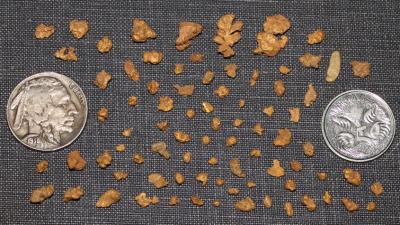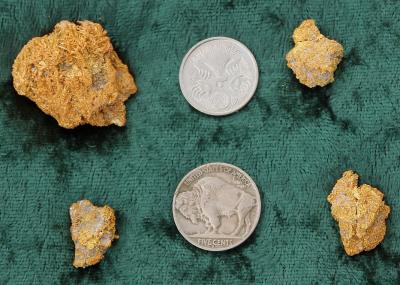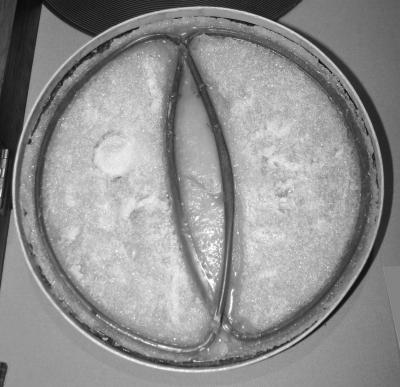-
Posts
883 -
Joined
-
Last visited
Content Type
Forums
Detector Prospector Home
Detector Database
Downloads
Everything posted by Reno Chris
-

Drones For Aerial Reconnaissance
Reno Chris replied to Steve Herschbach's topic in Detector Prospector Forum
I've never used a drone - Mostly I use Google Earth for those types of situations where I want to see things a bit before I get there. With commercially available low cost drones, you pretty much need to be on site - drones you cant really tell you what someplace many, many miles away is like - they don't transmit that far. Many have limits less than a mile. There are also legal restrictions on flying over some types of federal land. I am sure some day future prospectors will use drones, but I think its still a bit off in the future yet. -

Nokta Scores Spectacular Gold Specimen
Reno Chris replied to Steve Herschbach's topic in Nokta / Makro Metal Detectors
Very spectacular and quite a find in any location - California or Alaska or Nevada. The lower 48 isn't so bad, is it? -
I've certainly not had the same level of interference on my T2 that you had seen on your old F75. I never had any real problem with my T2 working parks and schools around town. Perhaps we could do a little testing after Jan 1st and a couple of local parks / schools while the kids are still out on vacation. Assuming the weather cooperates.
-
There are a few areas of very salty ground out in the Sawtooth area of Nevada. Not like the salt flats of WA, but way too salty to work except in a salt mode, especially if there is any dampness in the ground.
-

How Small Is Your Smallest Piece Of SDC 2300 Gold?
Reno Chris replied to rumblefish's topic in Minelab Metal Detectors
Mine is the side of an old hard backed book from the 1950s. -

Not Gold, But It Sure Was Loud
Reno Chris replied to Condor's topic in Rocks, Minerals, Gems & Geology
I would say not really. In some places cuprite is found with placer gold, in lots of other places no. It certainly is not some magic gold indicator. Yours look rounded like they have been rolled around in a stream for some distance. Its common in some copper mines. -

Not Gold, But It Sure Was Loud
Reno Chris replied to Condor's topic in Rocks, Minerals, Gems & Geology
These are almost certainly cuprite, a mineral which conducts electricity quite well. There is no way to discriminate them that I know of. They sound off on both VLFs and PIs. -

Targeting Specimen Type Gold With The SDC 2300
Reno Chris replied to Reno Chris's topic in Minelab Metal Detectors
Rick - HF is indeed nasty stuff and very toxic just like I said. Yes, you should not use it with your bare hands! No one should use it unless they fully understand the dangers. The product I mentioned using, Whink, is a cleaning product available at Walmart and contains about 1% HF in a buffered solution. I still would not use it with my bare hands but handled properly it can be used. I kept the jar with the nuggets of Whink and my nuggets in the garage to minimize the effect of any vapors that might have been created. -

How Small Is Your Smallest Piece Of SDC 2300 Gold?
Reno Chris replied to rumblefish's topic in Minelab Metal Detectors
I did use the SDC a bunch this summer and I got several pieces that weigh 0.03 grams (or half a grain), but none less. My scale goes to 0.002 grams. -

Targeting Specimen Type Gold With The SDC 2300
Reno Chris replied to Reno Chris's topic in Minelab Metal Detectors
Rick - I hope to get out there sometime next year and see what I can do to help you guys get some more gold. Gambler - I don't have pre-acid photos, but they were ugly and heavily covered with iron and some rock. Steve saw them - they were not pretty. The two on the left especially had only a little gold exposed as they were dug. They spent about 10 days in muratic, then about a week in Whink, which is a product with weak hydrofluoric acid. Hydrofluoric or HF is a very toxic acid capable of dissolving quartz and glass. It must be used in plastic containers and can release toxic fumes. AZblackbird - HF treatment is quite the art and I've heard plenty of stories of prospectors who turned pretty specimens into piles of tiny bits and wires of gold. It is very easy to over do it - if you take away all the rock, it can just fall completely apart. I got about a half gram of fines from this project which will go in with the rest of my fines. Gold cleaning thread in this forum http://www.detectorprospector.com/forum/topic/404-best-way-to-clean-gold/ -
It's well known that the SDC is finding a lot of small gold, but the truth is that it can also be used to find some larger types of specimen gold where the SDC also has an advantage over other detectors, because the response of wiry, porous gold is much like that of small gold even when the overall amount of gold is fairly large. Metal detectors work by seeing the eddy currents created by a magnetic field coming out of the detector’s coil. The eddy currents which are created in porous, mossy or wiry pieces of gold decay and disappear much more quickly than those which are created in solid pieces of gold of the same weight. This type of specimen gold behaves much more like a very small nugget even though the amount of gold contained within the specimen is good sized. The new MPF technology found in the SDC 2300 allows it to begin searching for eddy currents much more quickly than previous pulse induction detectors. This accounts for its ability to find smaller gold, but also allows the SDC 2300 to be very hot on specimen gold, and that is why I am making this post. If you want to find larger pieces of gold with your SDC 2300 that have been missed by others or could not have been detected with previous detectors, you need to be looking in places where specimen gold abounds or the gold is of the mossy, prickly, porous or wiry variety. So the next time you are thinking about where to prospect with your SDC 2300, remember that if you choose places rich in specimen gold you may be finding some very nice specimens with your detector. These nuggets were all iron stained ugly specimens a few weeks back but spent a lot of time soaking in acid. The larger nugget I found a few weeks back - plus a few more found a couple weeks before that. The small one below the bigger one is from California, the others are from Nevada. Biggest piece is 0.57 ounces, total is 0.9 ounces.
-

Best Metal Detector Rumors 2015
Reno Chris replied to Steve Herschbach's topic in Metal Detector Advice & Comparisons
Steve - think about the cross section we saw on the field training day after the Placerville ICMJ show - a lot of VLFs and a smattering of PIs. Interesting thought about the US sales. For profits at least among the better known makers, its been mostly about the sales in Africa as much or more than sales in the US and Australia. -

Minelab SDC 2300 Warranty Issue
Reno Chris replied to Rick K - First Member's topic in Minelab Metal Detectors
Yeah, the sticker is in a bad spot, but one of the issues detector makers have had with phony detectors is that the outside is where the mark is showing the detector is legitimate. The phony detector sellers will take the real guts out of a detector and put it in a fake. Then put the fake gut in the real detector. They then sell the body of the real detector, which still is marked with stickers showing it is real, and they can claim its a factory certified real detector, because the stickers on the outside say it is. Unfortunately the inside is no good and the buyer loses out. That is why the sticker straddles the two haves and says void if disturbed. Steve is right that it would have been much better on top. Still the whole pain of this exists because some Chinese thieves make products for the intent of committing fraud against others. -

Garrett ATX Strip Down & Rebuild
Reno Chris replied to Steve Herschbach's topic in Garrett Metal Detectors
Although the two circuit boards are clearly not the same, I am surprised how many similarities there actually are. -
Yep, the SDC is good on specimen gold.
-
The only time I have had issues with the SDC bump falsing, has been when the coil cover got full of sand. The coil cover is not the tightest and does fill up. You might check that before sending it in. JP and/or Steve can offer their opinions, but I would say that for nuggets less than 1.5 grams, the SDC would have an advantage over the 5000, nuggets in the 1.5 to 2.5 grams, they are pretty close, and bigger than that, the 5000 would have a depth advantage. I got one nugget about 1.2 grams as I remember that was about 6+ inches, but the signal at the ground surface very weak and I only dug on it as I had found other gold very close by.
-
The SDC is very, very sensitive and so responds to the the high EM interference around a house badly. At home is a poor place to performance test a PI detector - even after noise cancelling. You need to take it out far from power lines to get a more realistic evaluation of its performance. Its not really intended for "in town" use. I had no problems with touch sensitivity on green or dry plants with it in many hundreds of hours this summer in California, Nevada and Alaska. The SDC is not a detector for large nuggets deep, either. I dug a 3/8 ounce specimen piece at about 9 inches this summer in Alaska with my SDC, but if you want maximum depth of nuggets of a few grams and larger, you want to use a GPX 5000.
-

So What Is Inside That DD Coil?
Reno Chris replied to Steve Herschbach's topic in Metal Detector Advice & Comparisons
-

Using The XP DEUS For Gold Prospecting
Reno Chris replied to Steve Herschbach's topic in XP Metal Detectors
Has anyone in the US ever tried the XP Gold Maxx Power? Same maker as the Deus, but the coil has a cable. The XP Gold Maxx: http://depar-dubai.com/productSingle.php?id=76 Its another mid frequency do-everything gold detector. -

Its True What They Say About The SDC 2300
Reno Chris replied to schiara's topic in Minelab Metal Detectors
The only thing I would say about creeks is that some creeks (like in California and some other places) can be very trashy in places. The SDC has no discrimination and is not a great choice for working in very trashy areas. In streams that are not too trashy, it would be fine. -

Thankful I Am Not In Alaska!
Reno Chris replied to Steve Herschbach's topic in Detector Prospector Forum
JP has been to the US and says we put cinnamon on everything. So maybe peanut butter, cinnamon and honey. That might make a good sandwich. Must say that after trying marmite, I prefer cinnamon. Certainly been nice weather here for late November, but storms predicted on the way in a few days. There are times you can go out and prospect this time of year, but its just a day here and there - tough to plan for. -

Jupiter Visible at Dawn - the Minelab GPZ 7000
Reno Chris replied to Rick K - First Member's topic in Minelab Metal Detectors
That's kind of funny. A couple months after the SDC 2300 was out and available from dealers, I did something on the ML website and their pull down list of ML detectors did not have the SDC on it, even thought it was fully available and many folks had them. I sent in an email to let them know. Now this occurs with a detector not yet available for purchase anywhere, it's already on the list. I guess that means it will be available soon.- 8 replies
-
- detector tech
- minelab gpz 7000
-
(and 1 more)
Tagged with:
-

SDC 2300 Headphone Plug Part Number
Reno Chris replied to rumblefish's topic in Minelab Metal Detectors
neither of those are it. -

SDC 2300 Headphone Plug Part Number
Reno Chris replied to rumblefish's topic in Minelab Metal Detectors
I spent 3 hours looking on line one day and was unsuccessful in finding a match on line. I figure its some kind of oddball military spec thing.




